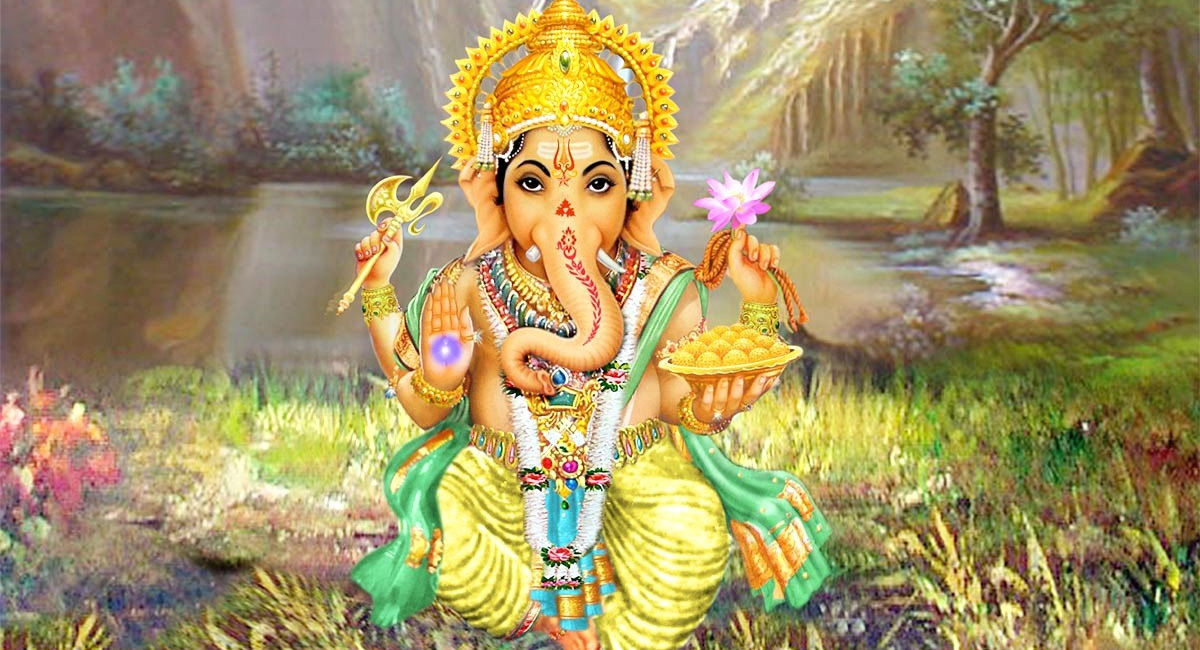Why God Ganesha is more Important in Hinduism?

Hinduism is among the world’s oldest religions, with roots going back more than 4,000 years in the Indian subcontinent. It is a rich and multifaceted religion, marked by a large number of gods, philosophies, rituals, and texts. Unlike most other religions, Hinduism does not have a founder, a central authority, or a widely accepted dogma. Rather, it has grown over the centuries, incorporating numerous cultural, spiritual, and philosophical influences.
The roots of Hinduism are in the Vedas, the earliest texts of Indian civilization, which are thought to have been written between 1500 and 500 BCE. Subsequent writings such as the Upanishads, Puranas, Ramayana, and Mahabharata also influenced Hindu beliefs and practices. Hinduism is rooted in the principles of Dharma (duty/righteousness), Karma (action and its result), and Moksha (release from the cycle of rebirth). The faith accepts an ultimate reality, Brahman, from which all things arise and to which all return.
Perhaps the most popular and most widely revered god in Hinduism is Lord Ganesha, the god with an elephant’s head, who occupies a unique position in the affections of millions of his followers across the globe.
Lord Ganesha: The Divine Remover of Obstacles
Who is Ganesha?
Lord Ganesha, or Ganapati, Vinayaka, and Pillaiyar, is one of Hinduism’s most revered deities. He is commonly worshiped as the remover of obstacles, the god of wisdom, and the protector of arts and sciences. His odd appearance, featuring his elephant head and pot belly, holds great symbolic significance. Ganesha is easily identifiable by his elephant head, flapping ears, pot belly, and his vahana (vehicle), a tiny mouse by the name of Mushak.
The Birth of Ganesha The most widely told account of Ganesha’s birth is related in the Shiva Purana. Legend says that Goddess Parvati formed Ganesha from the paste used for her bath, sandalwood. She gave life to him and appointed him the responsibility of watching her chamber when she bathed. When Lord Shiva returned home and encountered a young lad in his way, he got furious. Despite several warnings, Ganesha refused to let him pass, leading to a fierce battle in which Shiva beheaded Ganesha.
Seeing Parvati’s grief, Shiva promised to bring Ganesha back to life. He instructed his followers to find the head of the first living being they encountered, which happened to be an elephant. Thus, Ganesha was revived with an elephant’s head and was blessed by Shiva as the foremost god of worship before any new beginnings.
Why Does Ganesha Have an Elephant Head?
Ganesha’s elephant head represents wisdom, intelligence, and foresight. The huge ears signify listening and learning capacity, while the small eyes denote concentration. His trunk, which can execute minute as well as strong functions, signifies adaptability and efficiency.
Ganesha’s Family
- Father: Lord Shiva, destroyer and transformer among the Holy Trinity (Trimurti) in Hinduism.
- Mother: Goddess Parvati, divine consort of Shiva and the personification of Shakti (divine energy).
- Brother: Kartikeya (also called Skanda or Murugan), the war god and god of victory.
- Consorts: According to certain traditions, Ganesha is said to have two wives, Riddhi (prosperity) and Siddhi (spiritual power), whereas according to other traditions, he is unmarried.
Ganesha in Various Regions and Religions
- South India: Ganesha is widely worshiped as Pillaiyar and Vinayagar, particularly in Tamil Nadu. In Karnataka, he is referred to as Ganapati, and in Kerala, as Ganapathy.
- Buddhism and Jainism: Ganesha is portrayed as a guardian deity in both Indian Buddhism and Tibetan Buddhism. Ganesha is also recognized as a god who provides hope for success and prosperity by Jainism.
- Southeast Asia: Ganesha is even revered in Thailand, Indonesia, and Nepal, where he is frequently shown in Hindu-Buddhist art of ancient times.
Why is Ganesha Worshipped First?
Hindus call upon Lord Ganesha prior to embarking on anything new, from a wedding or business to a religious ceremony. This is based on a myth in which the gods proclaimed Ganesha the chief of all heavenly beings (Gana-isha) after a competition with his brother Kartikeya. Whereas Kartikeya traversed the globe, Ganesha went around his parents stating that they represented the whole world. Amused with his sagacity, Shiva and Parvati crowned him as the primary deity of devotion.
Other Common Myths Surrounding Ganesha
- The Shattered Tusk: As per the Mahabharata, Ganesha shattered his tusk so he could utilize it as a writing instrument to inscribe the epic while sage Vyasa dictated it. The tale represents sacrifice for the well-being of others.
- Ganesha and Kubera: Kubera, the goddess of wealth, once invited Ganesha to a dinner to flaunt his wealth. Ganesha consumed everything and was still hungry. When he requested more food, Kubera panicked. At last, Shiva gave Ganesha a handful of rice lovingly, which made him satiated, and the lesson to Kubera was that real wealth is humility and kindness.
- The Curse of the Moon: Ganesha once stumbled and fell off his mouse while riding one. The moon ridiculed him, and Ganesha cursed the moon to vanish. After pleading for mercy, Ganesha altered the curse so that the moon would increase and decrease periodically. This legend accounts for the phases of the moon and the reason why it is not good to look at the moon during Ganesh Chaturthi.
Ganesh Chaturthi: The Grand Festival Ganesh Chaturthi is the most popular festival in honor of Lord Ganesha. Celebrated in August-September, it includes grand processions, elaborate idols, devotional songs, and rituals ending with the immersion of Ganesha idols in water bodies.
Why Does Ganesha Have a Big Belly?
Ganesha’s big belly is usually understood as a representation of his capacity to digest all the experiences of life—both good and bad. It represents contentment, generosity, and the capacity to withstand and overcome challenges. Some mythological interpretations are:
- Symbol of the Universe: His belly symbolizes the universe, containing all the knowledge and secrets of the universe.
- Absorbing the Sorrows of Devotees: Lord Ganesha is said to take away the hardships and pains of his devotees into his belly, relieving them of troubles.
- Sign of Prosperity: One of the big bellies is also a symbol of prosperity and wealth, which Ganesha grants to his devotees.
- Represents the Three Worlds: According to some scriptures, his belly contains the three worlds—Swarga (heaven), Bhumi (earth), and Patala (underworld).
Ganesha’s Vehicle (Vahana) – The Mouse (Mushaka)
The vahana (vehicle) of Lord Ganesha is a tiny mouse called Mushaka. This selection of vehicle has immense symbolic importance:
- Master over Desires: The mouse symbolizes desires, which are little but can become uncontrollable. Ganesha riding the mouse indicates his master over desires and temptations.
- Overcoming Ego: Mouse is a personification of the ego, and it needs to be subdued. Ganesha, in his ride of the mouse, is representative of having overcome ego and pride.
- Virtue Overcoming Obstacles: Mice have a characteristic of creating passageways in narrow crevices. The mount of Ganesha signifies that he could traverse difficulties and hurdles of life.
- Small but Powerful: Even though small, the mouse is strong. This shows that even the smallest being can do tremendous work.
Mythological Tales of Lord Ganesha
- The Birth of Ganesha
One of the most well-known tales of Ganesha’s birth is related to Goddess Parvati and Lord Shiva. One day, Parvati, while bathing, made a boy from sandalwood paste and gave him life. She put him in charge of guarding her while she bathed. When Lord Shiva came back and attempted to enter, the boy halted him. Furious, Shiva decapitated the boy. Parvati, heartbroken, insisted he be revived. Shiva commanded his devotees to fetch the head of the first living creature they encountered, which was an elephant. Thus, Ganesha was reincarnated with an elephant’s head.
- Why Ganesha is Known as Ekadanta (One-Tusked)
There are numerous stories regarding Ganesha’s fractured tusk:
- Dictation of the Mahabharata: Sage Vyasa wished to dictate the epic Mahabharata and required a scribe. Ganesha consented on the basis that Vyasa would not take a halt while dictating. During the course of dictation, Ganesha’s pen snapped and he snapped off his tusk to keep writing without a halt.
- War against Parashurama: One day, Parashurama went to visit Shiva but was blocked by Ganesha. A battle followed, and Parashurama drove his axe into Ganesha’s tusk and shattered it.
- The Contest Between Ganesha and Kartikeya
Lord Shiva and Parvati once had a competition between their sons, Ganesha and Kartikeya, to see who was more intelligent. They were told to go around the world three times. Kartikeya, with his speedy peacock, embarked on the trip. Ganesha, knowing that his mouse moved slowly, merely went around his parents three times, stating that they were the whole universe. Shiva and Parvati were impressed and declared Ganesha the victor.
- The Curse of the Moon
One day, Ganesha, having eaten much sweets, was riding on his mouse when the mouse tripped and caused Ganesha to fall. The moon observed this and laughed. Enraged, Ganesha cursed the moon, that whoever looked at it on Ganesh Chaturthi day would suffer misfortune. For this reason, people do not look at the moon on the day.
- Ganesha and Kubera’s Pride
Kubera, the god of wealth, invited Ganesha for a feast, intending to show off his riches. Ganesha, known for his love of food, ate everything in Kubera’s palace and was still hungry. When Kubera admitted defeat, Ganesha advised him to serve food with humility instead of pride.
Conclusion Lord Ganesha’s importance transcends religious fronts. He represents wisdom, prosperity, humility, and perseverance. His tales impart us precious life teachings on devotion, wisdom, and righteousness. Be it in temples, at home, or in paintings, Ganesha is a much-loved god, inspiring millions towards accomplishment and enlightenment.
May Lord Ganesha take all challenges from your life and bless you with wisdom and prosperity! Ganpati Bappa Morya!







